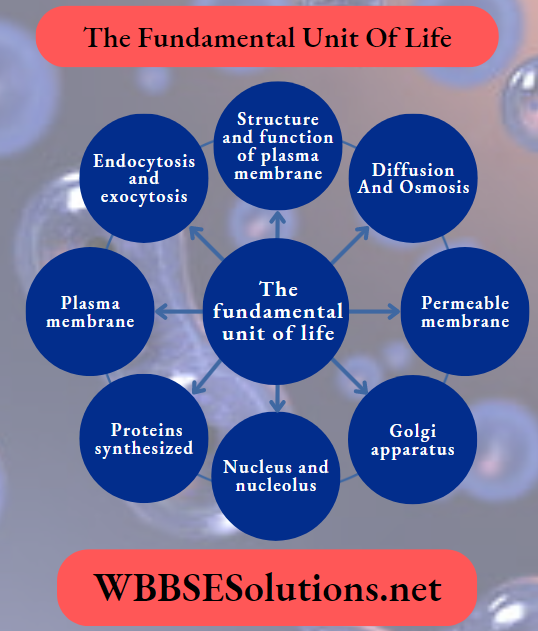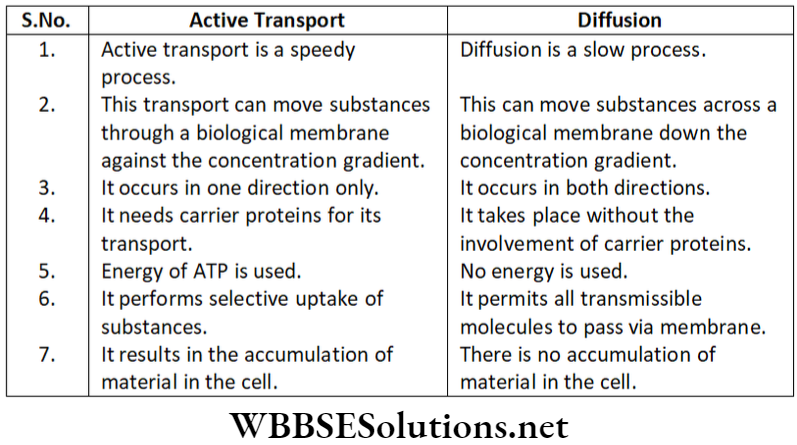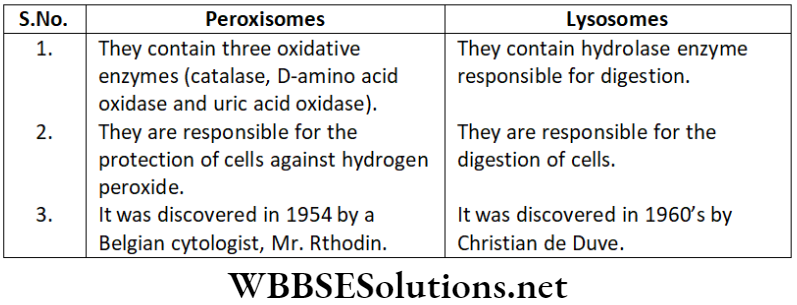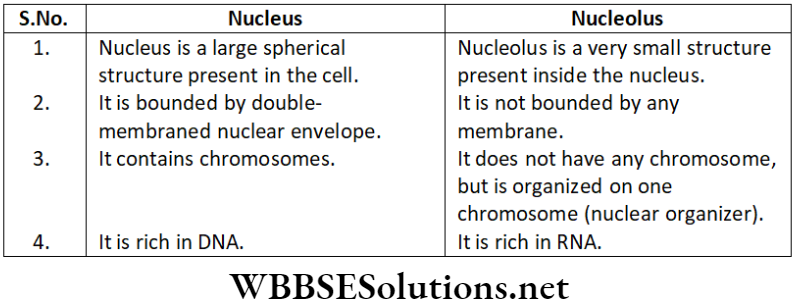Chapter 1 The Fundamental Unit Of Life Short Answer Type Question And Answers
Question 1. Discuss the structure and function of the plasma membrane.
Answer.
The structure and function of plasma membrane:
Delicate, elastic, and selectively permeable membrane. The membrane is almost made up of 75% phospholipids. It consists of proteins, cholesterol and polysaccharides.
Membrane is a semipermeable or selectively permeable membrane. It gives shape to cell and regulates the movement of molecules in and out of the cell.

Fundamental Unit Of Life Question Answer
Read And Learn More NEET Foundation Short Answer Questions
Question 2. Define diffusion and osmosis.
Answer.
Diffusion And Osmosis:
Diffusion is the net movement of solute particles from a region of high concentration to the region of low concentration. Osmosis is the passage of water or solvent from a region of high solvent concentration through a semipermeable membrane to a region of low solvent concentration.

Question 3. How do substances like CO2 and water move in and out of the cell? Discuss.
Answer.
Movement Of substances like CO2 and water move in and out of the cell:
The substances like CO2 and water move in and out of a cell through the process called diffusion from the region of concentrated region to low concentrated one. When the concentration of carbon dioxide and water is higher in external environment than that inside the cell, CO2 and water moves inside the cell. When the concentration outside the cell is low but it is high inside the cell, they move outwards.
Question 4. Discuss the difference between endocytosis and exocytosis.
Answer.
The difference between endocytosis and exocytosis:

Question 5. Why the plasma membrane is called a selectively permeable membrane?
Answer.
The plasma membrane is called a selectively permeable membrane:
Plasma membrane is called a selectively permeable membrane because it regulates the movement of substances from within to outside of the cell. This means that the plasma membrane allows the entry of some substances while preventing the movement of some other substance.
Question 6. Discuss the differences between active transport and diffusion.
Answer.
The differences between active transport and diffusion:

Fundamental Unit Of Life Question Answer
Question 7. Discuss the function of Golgi apparatus.
Answer.
The function of Golgi apparatus:
- Golgi apparatus acts as an assembly area for the storage, processing and packaging of various cellular secretions.
- It is involved in the synthesis of cell wall, plasma membrane and lysosomes
Question 8. Discuss why mitochondria is known as the power house of the cell.
Answer.
Mitochondria is known as the power house of the cell:
Mitochondria are known as the powerhouse of cells because the energy required for various chemical activities needed to support life is released by mitochondria in the form of ATP (Adenosine triphosphate) molecules.
Question 9. What are dictyosomes?
Answer.
Dictyosomes:
In plant cells, Golgi apparatus is present in the form of freely distributed subunits called dictyosomes.
| Class 11 Physics | Class 12 Maths | Class 11 Chemistry |
| NEET Foundation | Class 12 Physics | NEET Physics |
Question 10. Why are lysosomes known as suicide bags?
Answer.
Lysosomes known as suicide bags:
Lysosomes are called suicide bags because in case of any disturbance of their cellular metabolism, they release their own enzymes to digest their own cell.
Question 11. Where are proteins synthesized inside the cell?
Answer.
The proteins are synthesized in the ribosome.
Question 12. Discuss the characteristic features of peroxisomes and lysosomes.
Answer.
The characteristic features of peroxisomes and lysosomes:

Question 13. What are the characteristic differences between nucleus and nucleolus?
Answer.
The characteristic differences between nucleus and nucleolus:

Question 14. What would happen to the life of a cell if there was no Golgi apparatus?
Answer.
Golgi apparatus performs the function of a storage modification and packaging of products. If Golgi apparatus is not there, then the materials synthesized by cell will not be packaged and transported.
Question 15. Why the plasma membrane is called a selectively permeable membrane?
Answer:
The plasma membrane is called a selectively permeable membrane:
Plasma membrane is called a selectively permeable membrane because it regulates the movement of substances from within to outside of the cell. Selectively permeable describes the extreme selective nature of a membrane, wherein it specifically chooses certain molecules to pass. So, plasma membrane allows the entry of some substances while preventing the movement of some solutes.
Question 16. Who proposed the model called fluid mosaic model to explain the structure of functional cell membranes or plasma membranes?
Answer:
The model called fluid mosaic model to explain the structure of functional cell membranes or plasma membranes is proposed by
S. J. Singer and G. L. Nicolson (1972).
Question 17. Can you name the two organelles we have studied that contain their own genetic material?
Answer:
Mitochondria and plastids.
Question 18. If the organization of a cell is destroyed due to some physical or chemical influence, then what will happen?
Answer:
The organization of a cell is destroyed due to some physical or chemical influence:
If the organization of a cell is destroyed due to some physical or chemical influence then the cell will not be able to perform its basic functions, like digestion, excretion, respiration, etc. This may stop all the life activities and may come to an end.
Question 19. What is diffusion?
Answer:
Diffusion:
Diffusion is the net movement of solute particles from a region of high concentration to the region of low concentration.
Question 20. What would happen if the plasma membrane ruptures or breaks down?
Answer:
The plasma membrane ruptures or breaks down then
The cell will not be able to exchange material from its surroundings by diffusion. Due to this process, the protoplasmic material will disappear and the cell will die.
